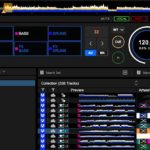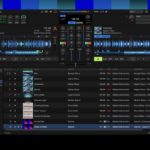
When Native Instruments came out with its Stems format a while back, many saw it as the way forward for DJing because it allowed for more control over a track’s playback (four “stems” that you can manipulate instead of the entire track). Combined with the Traktor Kontrol S8 controller, which was released ahead of the Stems format, the stage was set for Native Instruments’ vision for what DJing could be.
While that vision pans out (it’s too early to tell if it’ll reach mass adoption), and as DJs continue to wrap their heads around the format and imagine the possibilities, a steady stream of new tracks using the Stems format is being released daily on shopping sites like Beatport and Traxsource, but of greater interest to me was what I could do by making my own Stems.
I was intrigued by the Stem Creator Tool: at face value it’s not a big deal, but what it really offers you is the ability to produce tracks quickly which you can “perform” live using simple looping techniques, as well as fading parts of your production in and out (eg removing the drums, adding in a bass stem to another track, and so on) to create variations on the fly.
Because of this, you can come up with a short track you stitched together in under an hour, which is something I call a Stem Loop, and that’s what I’m going to show you in this four-part tutorial series.
What is a Stem Loop?
The music production process is a long one: you come up with musical ideas, program them in your digital audio workstation (DAW), arrange the elements to form parts of the song (what I call “chunks”), mix these elements for balance, and then send off to mastering.
This can take days, weeks, and months, which is fine – music making is a labour of love. But what if you’ve got an idea for a track that you want to “sketch” and test on the dancefloor? Or what if you just want to put together a track or two very quickly for a gig that you’ve got coming over the weekend? This is why I thought of making the Stem Loop. It’s a fast way to put a tune together which you can then perform live through looping in Traktor.

My Stem Loop idea allows you to quickly come up with a bite-sized production (usually just a little under two minutes long) using samples and loops from readily available sample packs such as those found on Beatport Sounds and Loopmasters. You assemble them in a DAW like Ableton Live, and then arrange the parts or “chunks” onto a template that I call a Stem Loop Map. After that, you export the tracks of your song into the Stem Creator Tool, and import the resulting Stem file into Traktor Pro 2, where you add hot cues and loop cues to your choice of chunks.
Once in Traktor Pro 2, you can then mix with the Stem Loop using those hot cues and cue loops, jumping from chunk to chunk and looping as needed.
What do I need to create and DJ with Stem Loops?
To DJ with Stem Loops, you need three things: Traktor Pro 2, a sample pack, and Ableton Live.
My idea for Stem Loops is rooted in the Stems file format, so you’ll need to be DJing with Traktor: this is a non-negotioable. It’d be a big plus (and more fun) if you had a Stems-ready controller like the Traktor Kontrol S8, S5, S4 Mk2, D2, or F1: that way, you don’t need to do any additional controller mappings. Of course you can just use your laptop’s keyboard to trigger hot cues and cue loops, but I highly recommend having a Traktor controller (I use the Traktor Kontrol S8 in this series).
Next, you’ll need a sample pack of loops and samples to create your Stem Loops with. You can get free and paid ones online from sites like Loopmasters and Beatport Sounds. In part two of this series, I’ll give you a sample pack that I created which you can download for free so you can try it out for yourself.
Lastly, you’ll need a copy of Ableton Live 9. It’s a powerful digital audio workstation (DAW), and is my app of choice when it comes to producing dance music. There’s a 30-day free trial over at the Ableton website, and you can use any version of Ableton Live 9 (Lite, Intro, Standard, and Suite) with this tutorial series.
Why DJ with Stem Loops?
My Stem Loop concept streamlines the production process because the elements you’re using have already been created (eg drum loops, bass loops, vocal snippets, and so on. You can add your own if you want), and it also makes arranging a no-brainer because you just fill in the Stem Loop Map, which has portions for chunks like the verse, chorus, breakdown, and others.
The Stem Loop process makes mixdowns quicker because you have the capability to further “mix” these individual Stem tracks while you’re DJing: feel like the bass isn’t hitting as hard as in the studio? Turn the other stems down, or turn up the bass stem while you’re DJing.
While the Stem Loop isn’t the same as producing an entire track from the ground up, obviously, it’s a quick way to put together a track and serves as a good introduction into how electronic dance music is made. It’s also a friendlier primer to those just starting to get into production because the time / effort commitment isn’t too daunting, and the learning curve isn’t too steep to climb.
Finally, the Stem Loop is unique in that it lets you multiply your mix options from a single track thanks to its Stems file format (ie drums, bass, synth, FX; bass, synth, FX only, and so on), and it also cuts down studio arrangement time considerably because you’re “performing the arrangement” as you DJ.

This is different from using Remix Decks, because Remix Decks are basically just loops that you trigger, while Stem Loops are parts of a song that you loop and jump to, manipulating them as you see fit. While this would’ve been possible with an MP3 track, you just don’t get the added flexibility of adjusting four individual tracks, which is why it’s such a great tool.
So in this video I’ll give a brief overview of the Stem Loop, and then I’ll demo how I DJ with a Stem Loop I created, improvising and mixing in and out of another commercially available Stem track that I’ve got playing.
In part two, we’ll download Ableton Live and install it on your computer if you still don’t have it, and then we’ll create a Stem Loop Map. In part three, we’ll download the DDJT Stem Loop sample pack and use it to fill in the chunks in your Stem Loop Map, then we’ll export the individual tracks of our project and plug them into the Stem Creator Tool to create our stem.
Finally in part four we’ll import our Stem Loop into Traktor Pro 2, add in the cues, and we’ll try DJing with it.
Tutorial Video
How do you DJ with Stems? Have you tried Stems out yet? Are you interested in learning a DJ/production trick such as this one? What would you like to learn about Stems? Let us know below.








